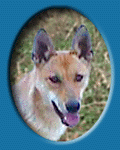Banbury Cross Farm
Carolina Dogs / American Dingos

"You're one of the very few who have actually preserved the breed and cared about them remaining true. We need more of that, and need to support those who do it right." -Raluca
CAES & CIA


CAES & CIA
Repare bem neste cao. Talvez wee esteja olhando, por assim
dizer, para o elo perdido com os caes primitivos das Americas.
E : ue pesquisas parecem indicar. >amado de Carolina Dog ou
de American Dingo, seu DNA tem ado alvo de estudos de
quatro." .ersidades norte-americanas. 1-5 -esultados sugerem
que o Ca- : "a Dog, comparado as demais ragas domesticas
desenvolvidas na regiao, teria de fato parentesco mais proximo
com os primeiros habitantes caninos do continente americano.
'^Sf^ 0 interesse cientffico por ele se deu gragas ao ecologista
Lehr Brisbin que, no final da decada de 70, se dedicava ao
estudo das origens dos caes antigos. Na ocasiao, Brisbin deparou com um cao similar ao Dingo Australiano, considerado por alguns outra subespecie do lobo, nao a mesma representada pelos demais caes domesticos. 0 ecologista, entao, localizou outros desses cachorros em areas isoladas da Carolina do Sul e da Georgia. 0 trabalho dele, noticiado pela Imprensa, acabou nos laboratories das universidades. Comunidade cientifica a parte, o Carolina Dog ja caiu nas gragas da criagao organizada. Em 1995, foi oficialmente reconhecido como raga pela segunda maior entidade norte-americana do segmento, o United Kennel Club. Tambem e aceito pela American Rare Breed Association. Permanece, contudo, fora do rol de ragas admitidas pela Federagao Cinologica Internacional e pelo American Kennel Club [AKC]. "Nao estamos muito preocupados com isso porque nao queremos que o Carolina Dog seja criado por muita gente e passe, portanto, a ter muita interferencia humana, o que, em poucas geragoes, o modificaria na aparencia e no temperamento", explica Jane Gunnell, presidente da The Carolina Dog Association. Segundo ela, soha no momento quatro pessoasenvolvidas na procriagao dessecao. "Ele e uma perfeita raga natural,e nos, humanos, nao somos capazes de melhorar a perfeigao", opina. Tanto nos EUA quanta no Canada, donos desses caes os mantem dentro de casa como companheiros familiares. "Os Carolina Dogs sao muito apegados as pessoas", diz Jane. Pelo padrao U KG, eles devem ter de 45 a 50 cm de altura e de 15 a 20 kg. Apresentam pelagem curta, orelhas eretas, cauda em anzol e cor vermelha em varios tons. Mais informagoes pelo site www.carolinadogs.org ou com Jane pelo e-mail jane@gforcecable.comTra
Translated
Look carefully at this dog. Perhaps we are looking, as it were, for the missing link with the primitive dogs of the Americas. And research seems to indicate. > beloved of Carolina Dog or American Dingo, his DNA has been targeted by studies of four North American countries. Five of five results suggest that the Dog, compared to other domestic races developed in the region, would in fact have closer kinship with the first canine inhabitants of the American continent. The scientific interest in it was given to the ecologist Lehr Brisbin who, at the end of the 1970s, devoted himself to the study of the origins of ancient dogs. At the time, Brisbin encountered a dog similar to the Australian Dingo, considered by some other subspecies of the wolf, not the same represented by the other domestic dogs. The ecologist then located other dogs in isolated areas of South Carolina and Georgia. His work, reported by the press, ended up in the universities' laboratories. Scientific community aside, the Carolina Dog has been recognized by the Gragas criagao organization. In 1995, he was officially recognized as the second largest entity raga North American Segment, the United Kennel Club. It is also accepted by the American Rare Breed Association. However, it remains off the list of ragas allowed by Federagao Cinologica International and the American Kennel Club [AKC]. "We are not very worried about this because we do not want the Carolina Dog to be created by a lot of people and therefore to have a lot of human interference, which in a few generations would change it in appearance and temperament," explains Jane Gunnell, president of The Carolina Dog Association. According to her, there are currently four people involved in breeding. "He is a perfect natural raga, and we humans are not able to improve perfection," she says. Both in the US and in Canada, owners of these dogs keep them indoors as family members. "Carolina Dogs are very attached to people," says Jane. By the standard UKG, they should be from 45 to 50 cm in height and from 15 to 20 kg. They have a short coat, straight ears, hooked tail and red color in several shades. More information on the website www.carolinadogs.com or Jane at janefoxandhound@gmail.com
CAES & CIA, December 2010